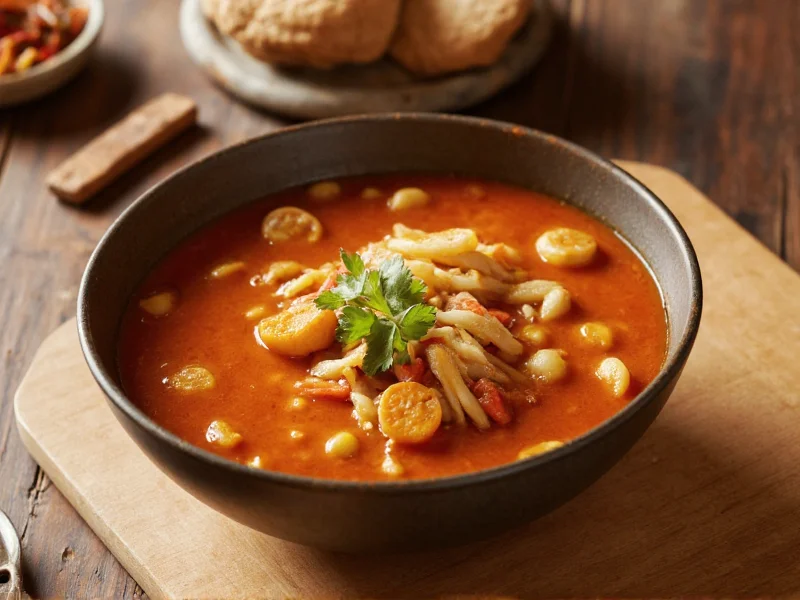Understanding Soup: More Than Just a Liquid Dish
While the basic definition seems straightforward, soup represents one of humanity's oldest and most universal food preparations. Archaeological evidence suggests humans have been making soup for at least 20,000 years, with early versions likely consisting of water heated in animal skins with added ingredients.
Core Characteristics That Define Soup
Several key elements distinguish soup from other liquid-based dishes:
| Characteristic | Description |
|---|---|
| Liquid Base | Must contain a significant amount of liquid (broth, stock, water, or milk) that forms the primary component |
| Flavor Extraction | Ingredients simmered to extract flavors into the liquid medium |
| Temperature Range | Served hot, warm, or cold depending on type and cultural tradition |
| Ingredient Ratio | Liquid component predominates over solid ingredients |
Soup vs. Similar Dishes: Understanding the Differences
Many people confuse soup with other liquid-based dishes. The distinction often comes down to ingredient ratios and preparation methods:
- Stew contains larger ingredient pieces with less liquid, designed to be eaten with a fork rather than spoon
- Chowder typically features chunky ingredients in a thicker, cream-based broth, often with potatoes
- Bisque represents a specific soup category—smooth, creamy, and often shellfish-based with a thickened texture
- Bouillon refers specifically to a clear broth, often used as a base for other soups
Major Categories of Soup
Soups fall into several fundamental categories based on preparation and ingredients:
Clear Soups
These include broths, consommés, and stocks where the liquid remains transparent. Traditional French consommé undergoes clarification to achieve crystal clarity while concentrating flavors.
Thick Soups
This diverse category encompasses:
- Pureed soups - Blended until smooth (like tomato or butternut squash)
- Cream soups - Thickened with dairy or alternative thickeners
- Bisque - Rich, creamy soups often featuring shellfish
- Chowders - Hearty, chunky soups with potatoes and cream
International Soup Traditions
Every culture has distinctive soup preparations that reflect local ingredients and culinary traditions:
- Asia - Miso soup (Japan), Tom Yum (Thailand), Hot and Sour soup (China)
- Europe - Borscht (Eastern Europe), Gazpacho (Spain), French onion soup
- Americas - Caldo (Latin America), Clam chowder (USA), Feijoada (Brazil)
- Africa - Egusi soup (West Africa), Harira (North Africa)
The Science Behind Soup Making
Creating exceptional soup involves understanding several scientific principles:
- Extraction - Simmering releases flavors, nutrients, and collagen from bones and vegetables
- Emulsification - Proper technique creates stable mixtures of fat and liquid
- Thickening mechanisms - Understanding how roux, purees, or starches affect texture
- Temperature control - Maintaining proper simmer prevents ingredient breakdown
Modern Soup Innovations
Contemporary chefs continue to innovate within this ancient food category:
- Molecular gastronomy applications - Creating soup "caviar" or air-infused broths
- Deconstructed soups - Presenting components separately for interactive dining
- Global fusion - Combining traditional elements from multiple culinary traditions
- Sustainable approaches - Using vegetable scraps and food waste for zero-waste broths
Cultural Significance of Soup
Beyond nourishment, soup carries deep cultural meaning worldwide. Many societies use soup for:
- Comfort during illness (chicken soup's reputation as "Jewish penicillin")
- Community building (stone soup traditions)
- Ritual and celebration (lentil soup for New Year's in many cultures)
- Economic sustenance (historically, soup kitchens provided essential nourishment)
Creating Perfect Soup at Home
Whether you're making a simple weeknight soup or an elaborate consommé, these principles apply:
- Start with quality ingredients—fresh vegetables and proper bones for stocks
- Maintain proper temperature (simmer, don't boil vigorously)
- Layer flavors through proper technique (sautéing aromatics first)
- Season gradually and taste throughout the cooking process
- Allow proper resting time for flavors to meld











 浙公网安备
33010002000092号
浙公网安备
33010002000092号 浙B2-20120091-4
浙B2-20120091-4